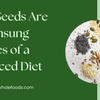The Ultimate Guide to Eating Whole Foods in Winter
- by K V
As the winter chill settles over the UK, the days grow shorter, and the nights longer, our cravings for comfort food kick into high gear. But instead of turning to heavily processed takeaways or sugary treats, why not embrace the natural goodness of whole foods? This winter, let’s explore how to nourish our bodies with wholesome, seasonal ingredients that not only keep us warm but also support our health and wellbeing.
Why Whole Foods?
Whole foods are ingredients in their most natural form—think fresh vegetables, fruits, whole grains, nuts, and seeds. They’re unrefined, free from artificial additives, and packed with nutrients that processed foods simply can’t match. During winter, when our immune systems are more vulnerable and energy levels can dip, whole foods provide the essential vitamins, minerals, and fibre we need to stay healthy and energised.
For example, vitamin C-rich foods like kale and citrus fruits can give your immune system a boost, while the fibre in whole grains and vegetables supports digestion. Plus, by choosing seasonal and locally sourced produce, you’re not only eating better but also supporting local farmers and reducing your environmental impact.
Seasonal Produce to Embrace
Winter in the UK might seem like a lean time for fresh produce, but it’s actually the season for some truly remarkable ingredients. Here are a few to look out for:
1. Root Vegetables
Carrots, parsnips, swedes, and potatoes are winter staples. These hearty vegetables are perfect for roasting, stewing, or mashing. Their natural sweetness shines in warming dishes like soups and casseroles.
2. Leafy Greens
Robust greens like kale, spinach, and Swiss chard thrive in colder months. Add them to soups, stir-fries, or salads for a nutrient-packed boost. Their slightly bitter flavours balance out richer ingredients beautifully.
3. Whole Grains
Nothing beats a warm bowl of porridge on a cold morning. Barley, quinoa, and brown rice are also great for hearty side dishes or bulking up soups and stews.
4. Fruits
While summer might be peak fruit season, winter still offers gems like apples, pears, and forced rhubarb. Enjoy them fresh, baked into desserts, or even added to savoury dishes for a touch of sweetness.
5. Nuts and Seeds
Almonds, walnuts, and chia seeds are packed with healthy fats and protein, making them perfect for snacking or sprinkling over porridge and salads.
How to Incorporate Whole Foods into Your Winter Diet
Adopting a whole foods approach during winter doesn’t have to be complicated. Here are some simple ideas to get you started:
1. Warm and Hearty Soups and Stews
Soups and stews are winter essentials. Try a vegetable stew loaded with root vegetables, leafy greens, and barley. It’s filling, nutritious, and perfect for frosty days.
2. Revamp Your Roast
Swap out the usual roast dinner trimmings for a colourful vegetable medley. Roast parsnips, carrots, swedes, and Brussels sprouts with olive oil and thyme. Serve with a lean protein for a balanced meal.
3. Hearty Breakfasts
Ditch sugary cereals for a bowl of porridge or muesli. Top it with chopped apples or pears, a handful of nuts, and a sprinkle of cinnamon. It’s a delicious way to start your day with energy.
4. Smart Snacking
Instead of reaching for crisps or chocolate, keep whole food snacks on hand. Fresh fruit, a handful of mixed nuts, or a slice of whole grain bread with avocado are great options.
Tips for a Successful Winter of Whole Foods
1. Plan Your Meals
A little planning goes a long way. Spend some time each week planning meals around seasonal produce. This makes shopping easier and ensures you always have healthy options ready.
2. Shop Local
The UK is home to fantastic local markets and independent grocers, but if you’re looking for a convenient way to access fresh, seasonal produce without leaving your home, Maven Wholefoods is here to help. By shopping online at mavenwholefoods.com, you can explore a wide range of high-quality, locally sourced whole foods delivered straight to your door. Not only does this save you time, but it also supports small businesses and reduces your environmental footprint
3. Keep It Simple
You don’t need to be a master chef to create delicious whole food meals. Sometimes, a basic vegetable soup or a warm bowl of porridge is all you need to feel nourished and satisfied.
4. Experiment and Enjoy
Winter is a great time to experiment with spices and herbs. Try adding cinnamon, ginger, or turmeric to your dishes for extra warmth and flavour.
Final Thoughts
This winter, let’s embrace the vibrant flavours and rich textures that whole foods have to offer. By focusing on seasonal, nutrient-dense ingredients, you’re not just preparing meals—you’re nurturing your body and mind during a time when we all need a little extra care.
So, whether it’s a steaming bowl of vegetable stew, a hearty breakfast of porridge, or a simple roasted vegetable medley, whole foods can bring warmth, comfort, and wholesome goodness to your winter table. Here’s to a season of nourishment, balance, and delicious eating!
- Posted in:
- healthy winter recipes
- seasonal eating UK
- sustainable eating
- UK winter whole foods
- Whole Foods Market UK





